We’ve all been there – standing in the kitchen with a French press in hand, wondering if we’re about to create coffee magic or a bitter disaster. The French press, also known as a cafetière or coffee plunger, has been brewing perfect cups since the 1920s, and it’s time we mastered this simple yet elegant brewing method.
Why should we care about French press coffee? This immersion brewing technique gives us complete control over our coffee’s strength and flavor profile. Unlike drip coffee makers that rush water through grounds, the French press allows coffee and water to mingle for the perfect amount of time, extracting rich oils and bold flavors that paper filters typically trap.
We’re about to walk you through the step-by-step process that’ll transform your morning routine. From choosing the right grind size to timing your brew perfectly, you’ll discover why coffee enthusiasts swear by this foolproof method for consistently delicious results.
What You’ll Need
Before we jump into the brewing process, let’s gather everything required for perfect French press coffee. Having the right equipment and ingredients ready ensures smooth brewing from start to finish.
Essential Equipment
French Press Coffee Maker
We recommend choosing a French press with a capacity that matches your daily coffee consumption. Standard sizes range from 12 ounces for single servings to 34 ounces for multiple cups.
Coffee Grinder
A burr grinder delivers the most consistent results for French press brewing. Blade grinders work as an alternative but may produce uneven particle sizes that affect extraction.
Kitchen Scale
Digital scales provide precise measurements for both coffee and water ratios. This accuracy ensures consistent flavor profiles with every brew.
Timer
Brewing time directly impacts flavor extraction. We use either a smartphone timer or standalone kitchen timer to track the four-minute steeping process.
Kettle
A gooseneck kettle offers better pouring control though any kettle works for heating water. Electric kettles with temperature controls help achieve optimal brewing temperature.
Wooden Spoon or Stirrer
Metal spoons can scratch the glass carafe or interfere with the brewing process. Wooden or plastic stirrers prevent damage while ensuring even saturation.
Coffee and Water Requirements
Coffee Beans
Fresh whole beans produce the best French press coffee. We recommend using beans roasted within two weeks of brewing for optimal flavor. Medium to dark roasts work particularly well with the French press method.
Grind Size
Coarse grinds are essential for French press brewing. The particles should resemble breadcrumbs or coarse sea salt. Fine grinds pass through the mesh filter and create muddy coffee.
Water Quality
Filtered water eliminates chlorine and impurities that interfere with coffee flavors. The water should taste clean and neutral since it comprises 98% of your finished coffee.
Coffee to Water Ratio
The standard ratio is 1:15 or 1:16 coffee to water. This translates to roughly 1 ounce of coffee for every 15-16 ounces of water. Adjust according to your taste preferences.
| Component | Measurement | Notes |
|---|---|---|
| Coffee | 1 oz (28g) | Coarse grind |
| Water | 15-16 oz (450-480ml) | Filtered preferred |
| Temperature | 195-205°F (90-96°C) | Just off boiling |
| Brew Time | 4 minutes | Standard steeping |
Ingredients
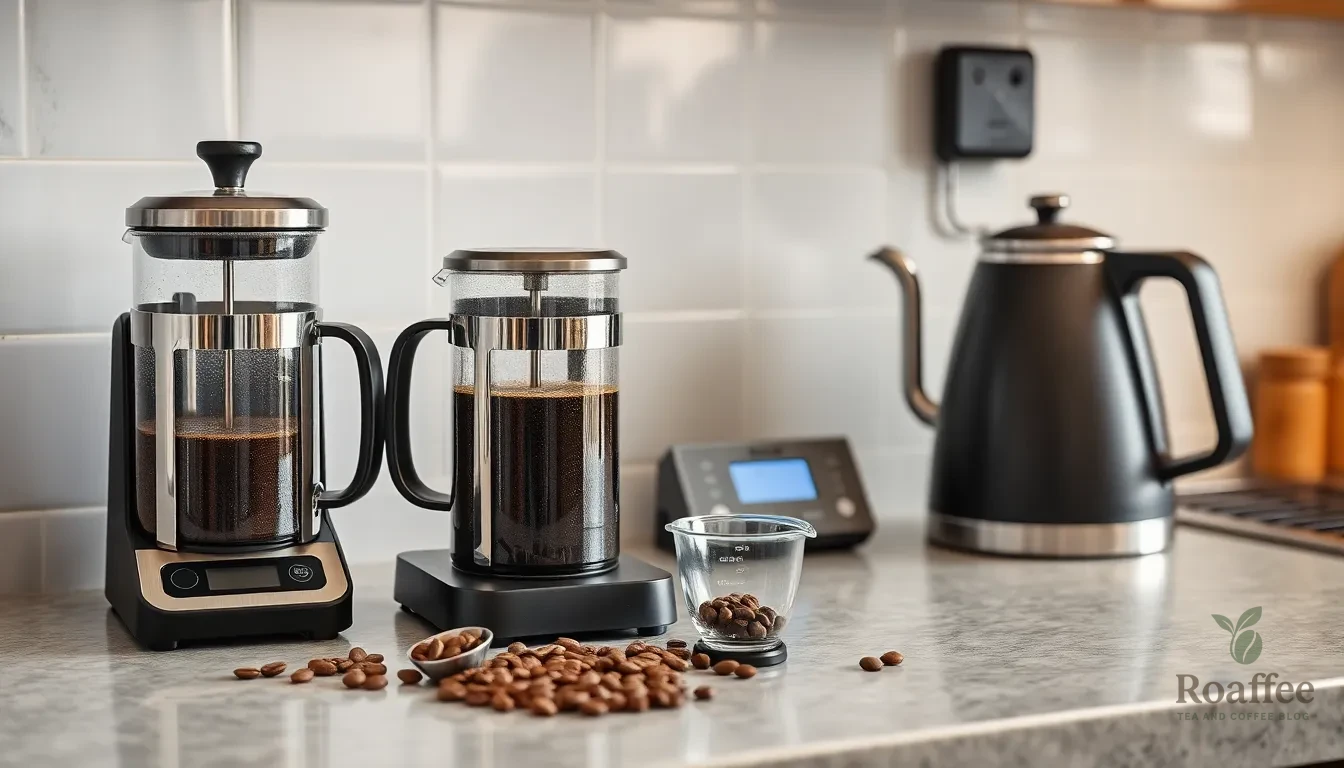
Fresh whole coffee beans form the foundation of exceptional French press coffee. We recommend selecting beans roasted within two weeks of brewing for optimal flavor extraction. The origin and roast level depend on your taste preferences but medium to dark roasts typically work well with this brewing method.
For the Coffee:
- 30-60 grams coarsely ground coffee (depending on French press size)
- Grind size should resemble coarse sea salt to prevent clogging
- Use a burr grinder for consistent particle size
For the Water:
- Filtered water heated to 200-205°F
- Amount varies by French press capacity (typically 450-1000ml)
- Water quality significantly impacts final taste
Essential Ratios:
| Component | Measurement | Notes |
|---|---|---|
| Coffee to Water Ratio | 1:15 to 1:16 | Adjust based on strength preference |
| Water Temperature | 200-205°F | Just off boiling point |
| Brew Time | 4-6 minutes | Longer steeping creates stronger coffee |
Additional Requirements:
- Non-metal stirrer (wooden or plastic)
- Timer or stopwatch for precise timing
- Digital scale for accurate measurements (optional but recommended)
We emphasize using filtered water because tap water minerals can interfere with extraction and create off flavors. The coarse grind prevents over-extraction and makes plunging easier while allowing proper water circulation through the grounds. Fresh grinding just before brewing preserves essential oils and aromatic compounds that contribute to the rich full-bodied flavor French press coffee is known for.
Step-by-Step Instructions
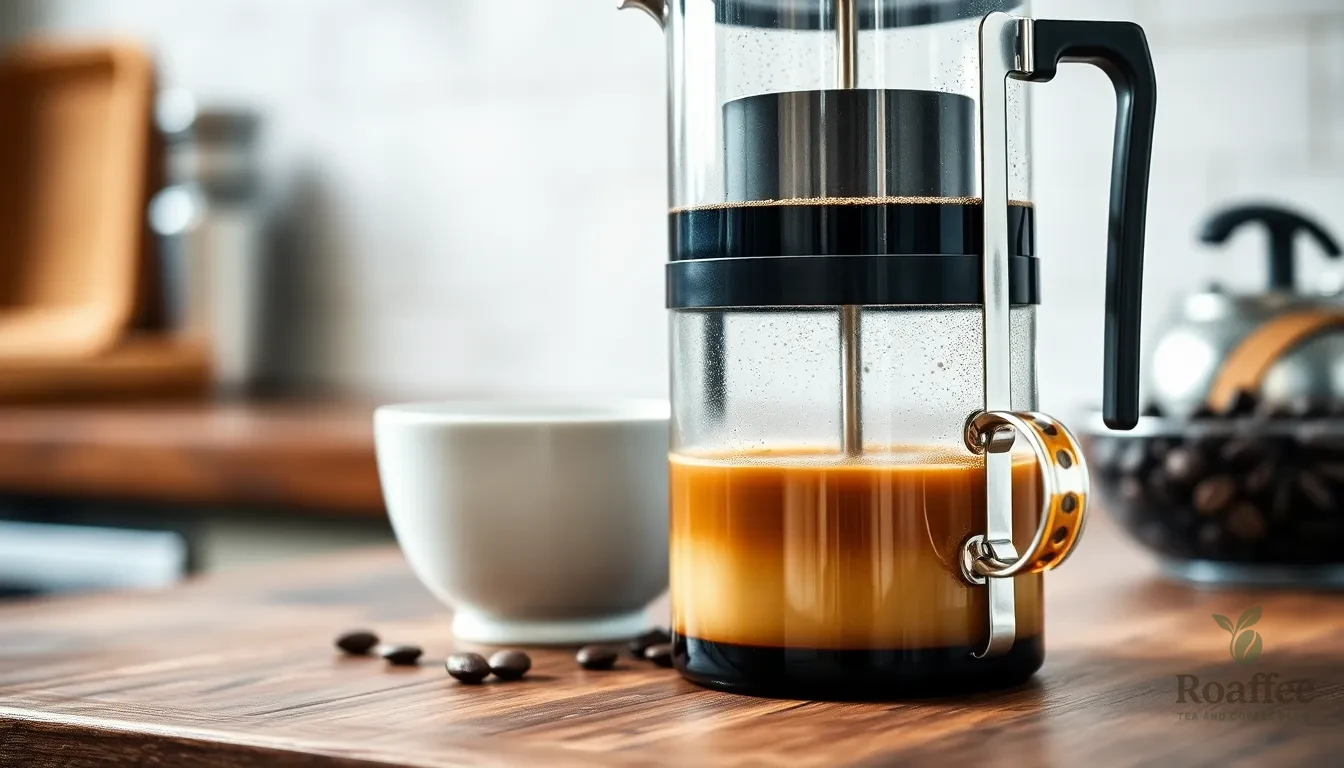
Now that we have our equipment and ingredients ready, let’s walk through the precise process of brewing exceptional French press coffee. These detailed steps will help us achieve that rich, full-bodied flavor we’re after.
Prep Your French Press
We begin by warming our French press to maintain optimal brewing temperature throughout the process. Fill the press about one-quarter full with hot water and press the plunger down completely. Swirl the water for 10 seconds to warm the glass thoroughly, then remove and discard the rinse water. This essential step prevents heat loss during brewing and ensures our coffee stays at the proper temperature for maximum flavor extraction.
Heat the Water
Water temperature plays a crucial role in extracting the perfect flavors from our coffee grounds. We heat water to a rolling boil, then let it cool slightly to about 205°F, which is just below the boiling point. This temperature range prevents burning the coffee while ensuring optimal extraction of flavors and oils. Using water that’s too hot can result in bitter, over-extracted coffee, while water that’s too cool won’t extract enough flavor compounds.
Measure and Grind Your Coffee
Precision in measurement creates consistency in our brewing results. We use 30-50 grams of coffee for a typical 4-cup French press, depending on our desired strength. Fresh whole beans should be ground to a coarse, even consistency similar to breadcrumbs but not too fine. The coarse grind prevents clogging of the mesh filter and allows for proper water flow during extraction. Grinding our beans immediately before brewing preserves the essential oils and aromatic compounds that create exceptional flavor.
Add Coffee to the French Press
We pour the freshly ground coffee into our warmed French press, ensuring even distribution across the bottom. Gently shake the press to level the grounds, creating a uniform surface for water contact. This step ensures consistent extraction across all the coffee grounds and prevents channeling, where water flows through some areas more than others.
Pour and Steep
The pouring technique significantly impacts flavor development in our brew. We start by pouring about half of the hot water evenly over the coffee grounds to begin the bloom phase, which releases carbon dioxide and enhances flavor extraction. After 30 seconds, we gently stir to break the crust of grounds that forms on top. Next, we pour the remaining water, place the lid with the plunger pulled up, and let the coffee steep for exactly 4 minutes. This timing allows for complete extraction without over-brewing.
Press and Serve
When our 4-minute timer sounds, we slowly and steadily press the plunger down to separate the grounds from the brewed coffee. Applying even pressure prevents grounds from escaping into our cup while maintaining the clean separation we want. We pour the coffee immediately into our cups to avoid bitterness from over-extraction. Leaving coffee in the French press after plunging continues the extraction process and can result in bitter, unpleasant flavors.
Pro Tips for Perfect French Press Coffee
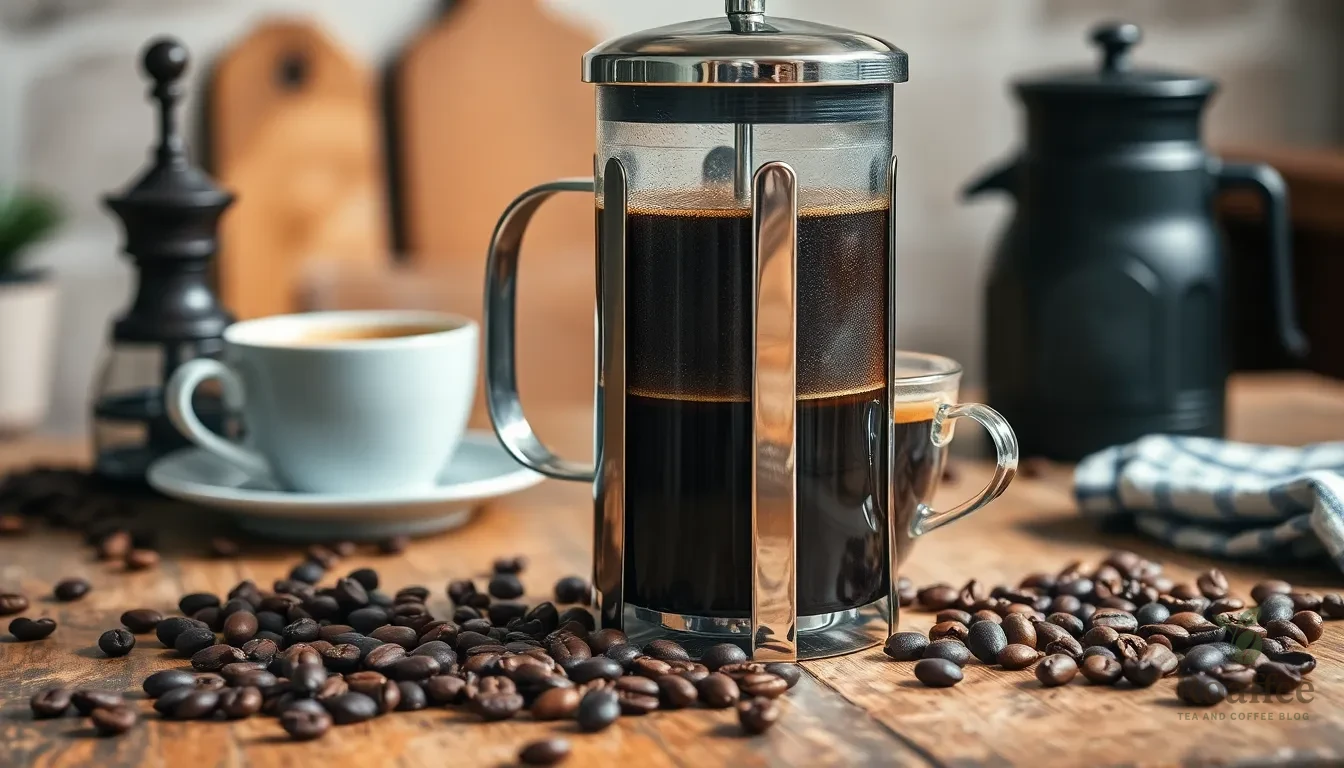
These expert techniques will elevate your French press brewing from good to exceptional. We’ve refined our approach through countless brewing sessions to bring you the most effective methods for consistently outstanding results.
Choosing the Right Coffee Beans
Fresh whole bean coffee forms the foundation of exceptional French press coffee. We recommend selecting beans roasted within two weeks of brewing for optimal flavor extraction. Medium to dark roasts typically deliver the best results in French press brewing due to their robust flavor profiles that complement the immersion method.
Grind size makes or breaks your coffee experience. We grind our beans to a very coarse consistency similar to coarse salt or steel-cut oats. This prevents clogging the mesh filter while allowing proper water flow during extraction. When your coffee tastes weak we recommend grinding slightly finer. If it tastes over-extracted or bitter we suggest grinding coarser to reduce extraction time.
Getting the Water Temperature Right
Water temperature directly impacts flavor extraction and overall coffee quality. We heat our water to approximately 205°F which is just off boiling point. This temperature ensures optimal extraction without scorching the coffee grounds or creating bitter compounds.
Different roasts require slight temperature adjustments for best results. Dark roasts and decaffeinated coffees perform better at slightly cooler temperatures around 190-195°F. Pouring water that’s too hot or too cold affects the final flavor profile significantly. We use a thermometer or let boiling water rest for 30 seconds to reach the ideal temperature.
Timing Your Brew
Precise timing creates the perfect balance between under-extraction and over-extraction. We start by adding our coarse ground coffee to the French press using approximately 60-70 grams per liter of water. Pour about half the hot water over the grounds to create a bloom that releases aromatic compounds for 30 seconds.
After the bloom period we stir gently for 5 seconds to break up the crust formation. Add the remaining water and place the lid with the plunger pulled up. Steep for exactly 4 minutes to achieve optimal extraction. We then press the plunger down slowly over 20 seconds to avoid agitating the grounds.
Immediate serving prevents over-extraction and bitterness. We pour the coffee into cups right after pressing to stop the brewing process. This timing method consistently produces rich full-bodied coffee with balanced acidity and minimal bitterness.
Troubleshooting Common Issues
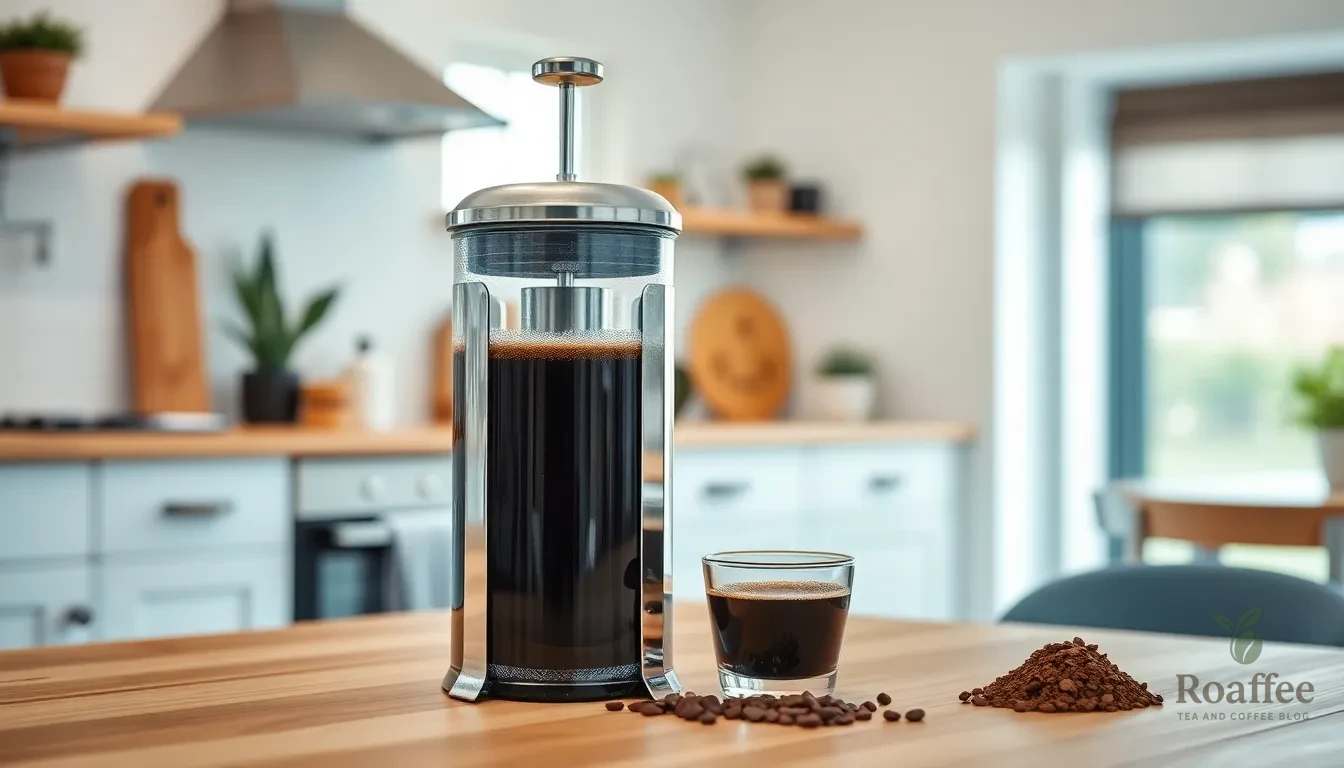
Even experienced coffee enthusiasts encounter brewing challenges with their French press. We’ll address the most common problems and provide practical answers to ensure consistently delicious coffee every time.
Coffee Tastes Bitter
Bitter coffee typically results from over-extraction caused by grind size that’s too fine or excessive brewing time. When we use a fine grind, the increased surface area allows water to extract compounds too quickly, leading to harsh, bitter flavors.
To fix bitter coffee, we recommend adjusting your grind to resemble coarse sea salt. This texture prevents the water from extracting bitter compounds while still allowing proper flavor development. Also, reducing your steeping time can help balance the extraction process.
Coffee Tastes Weak
Weak coffee indicates under-extraction, which occurs when our brewing variables don’t allow sufficient flavor extraction from the coffee grounds. This problem commonly stems from using too coarse a grind, insufficient coffee grounds, or inadequate steeping time.
We suggest making your grind slightly finer while maintaining the coarse texture to increase extraction without creating bitterness. Increasing your coffee dose or extending the steeping time by 30 seconds to 1 minute can also strengthen the brew. Remember that our recommended ratio of 1 gram coffee per 15 grams water provides a solid foundation for adjustments.
Grounds in Your Cup
Coffee grounds in your cup result from pressing the plunger too quickly or using grind that’s too fine for French press brewing. Fast plunging creates turbulence that forces grounds through the metal filter, while fine particles easily pass through the mesh.
We recommend pressing the plunger slowly with steady, even pressure to minimize grounds escaping into your coffee. Using a coarser grind ensures particles remain large enough for the filter to catch them effectively. A burr grinder helps achieve consistent particle size, reducing the likelihood of fine grounds contaminating your cup.
Cleaning and Maintenance
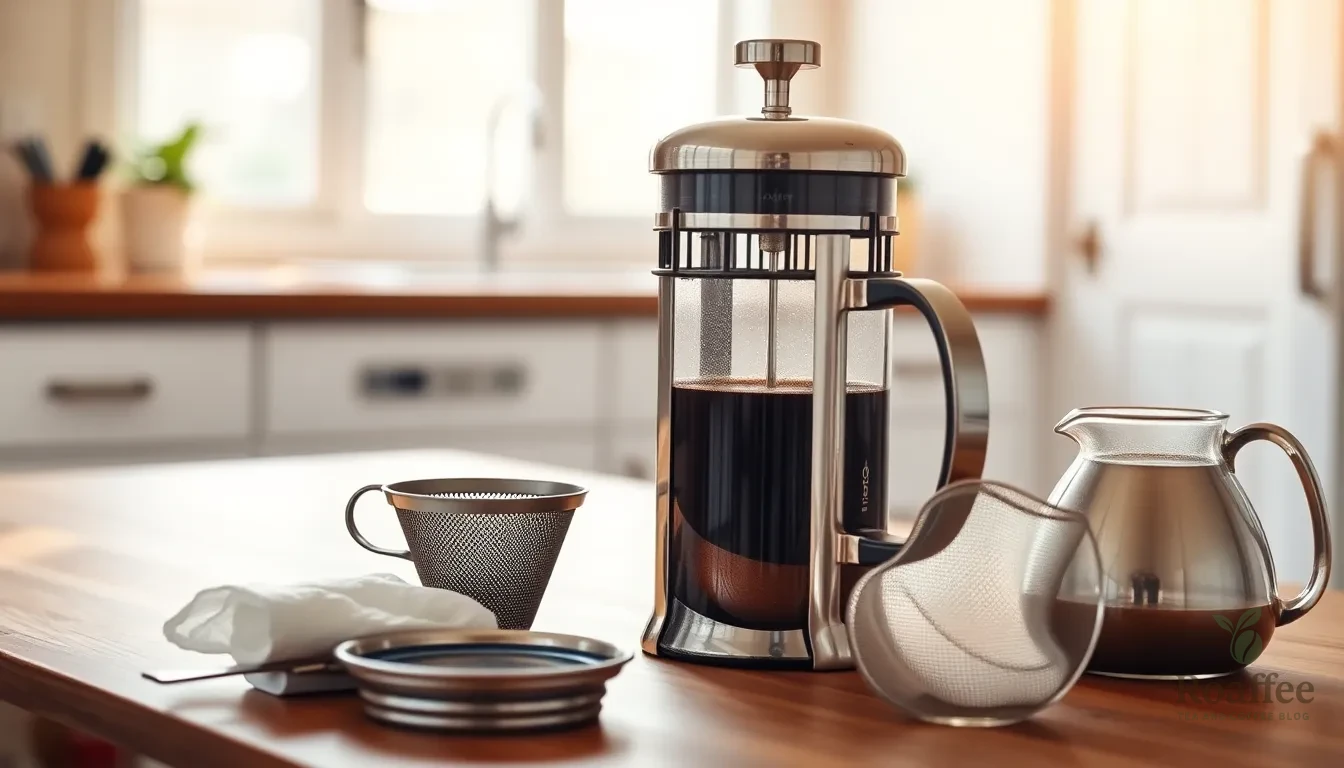
Proper maintenance of your French press ensures consistently delicious coffee and extends the life of your equipment. We’ll guide you through both daily and deep cleaning techniques that keep your brewing device in optimal condition.
Daily Cleaning
After each brewing session, we recommend following these essential steps to maintain your French press. Start by removing coffee grounds completely from the carafe—dump them into a trash or compost bin rather than down the drain to prevent clogs. Use a rubber or wooden tool to scoop out any stubborn grounds that stick to the bottom.
Next, disassemble all components of your French press for thorough cleaning. Rinse each part with warm water to remove initial coffee residue and oils. Fill the carafe with hot water and a few drops of dish soap, then plunge the mesh filter up and down several times to agitate the soapy water and clean the filter thoroughly.
Rinse all parts well under running water to remove soap residue. Air dry the components on a drying rack or immediately dry them with a lint-free cloth to prevent water spots and mineral buildup.
Deep Cleaning
Weekly deep cleaning maintains optimal performance and prevents stale flavors from developing in your French press. Disassemble all parts and soak the mesh filter and carafe in warm soapy water for 15-30 minutes to loosen stubborn coffee oils and residue.
Use a soft brush to gently scrub away any coffee buildup from the mesh filter and carafe walls. Pay special attention to the filter screen where oils tend to accumulate over time. Rinse all components thoroughly under running water to ensure complete removal of soap and loosened debris.
Dry each part completely before reassembling your French press. This prevents moisture from creating an environment where bacteria or mold could develop, ensuring your next cup of coffee tastes fresh and clean.
Make-Ahead Tips

French press coffee brewing becomes significantly easier when we prepare certain elements in advance. These strategic preparations save time during busy mornings while ensuring consistent quality in every cup.
Pre-Grind Coffee Beans
We can grind coffee beans up to 24 hours ahead of brewing time. Store freshly ground coffee in an airtight container at room temperature to preserve flavor compounds. Vacuum-sealed containers work exceptionally well for maintaining freshness. Beyond 24 hours ground coffee begins losing essential oils and aromatic compounds that contribute to rich flavor profiles.
Prepare Water Temperature
Water temperature plays a crucial role in extraction timing. We recommend heating water to 205°F the night before and storing it in a thermal carafe or insulated container. This approach eliminates morning wait time and ensures optimal brewing temperature. Alternatively programmable electric kettles can automatically heat water at scheduled times.
Measure Coffee Portions
Pre-portioning coffee grounds streamlines the brewing process significantly. We suggest measuring 30-60 grams of ground coffee based on French press capacity and storing portions in individual containers. Small mason jars or coffee canisters work perfectly for this purpose. Label each container with the intended brew size for easy identification.
Set Up French Press Components
Evening preparation includes assembling the French press with all components readily accessible. Position the French press carafe plunger and filter assembly on the counter near your coffee station. We also recommend placing a timer and stirring utensil within easy reach to avoid morning scrambling.
Batch Brew Concentrate
For households with multiple coffee drinkers we can prepare French press concentrate using a 1:8 coffee-to-water ratio. This concentrated brew stores well in the refrigerator for up to three days. Simply dilute with hot water at serving time to achieve desired strength. This method proves especially useful for entertaining guests or preparing multiple servings quickly.
| Make-Ahead Element | Storage Time | Storage Method |
|---|---|---|
| Ground Coffee | 24 hours | Airtight container at room temperature |
| Heated Water | 12 hours | Thermal carafe or insulated container |
| Coffee Portions | 1 week | Individual containers with labels |
| French Press Concentrate | 3 days | Refrigerator storage |
Morning Assembly Strategy
We recommend establishing a consistent morning routine that takes advantage of these preparations. Start by adding pre-measured coffee grounds to the warmed French press. Pour the prepared hot water following the standard blooming and steeping process. This systematic approach reduces brewing time from 8-10 minutes to approximately 5 minutes while maintaining quality standards.
Storage Recommendations
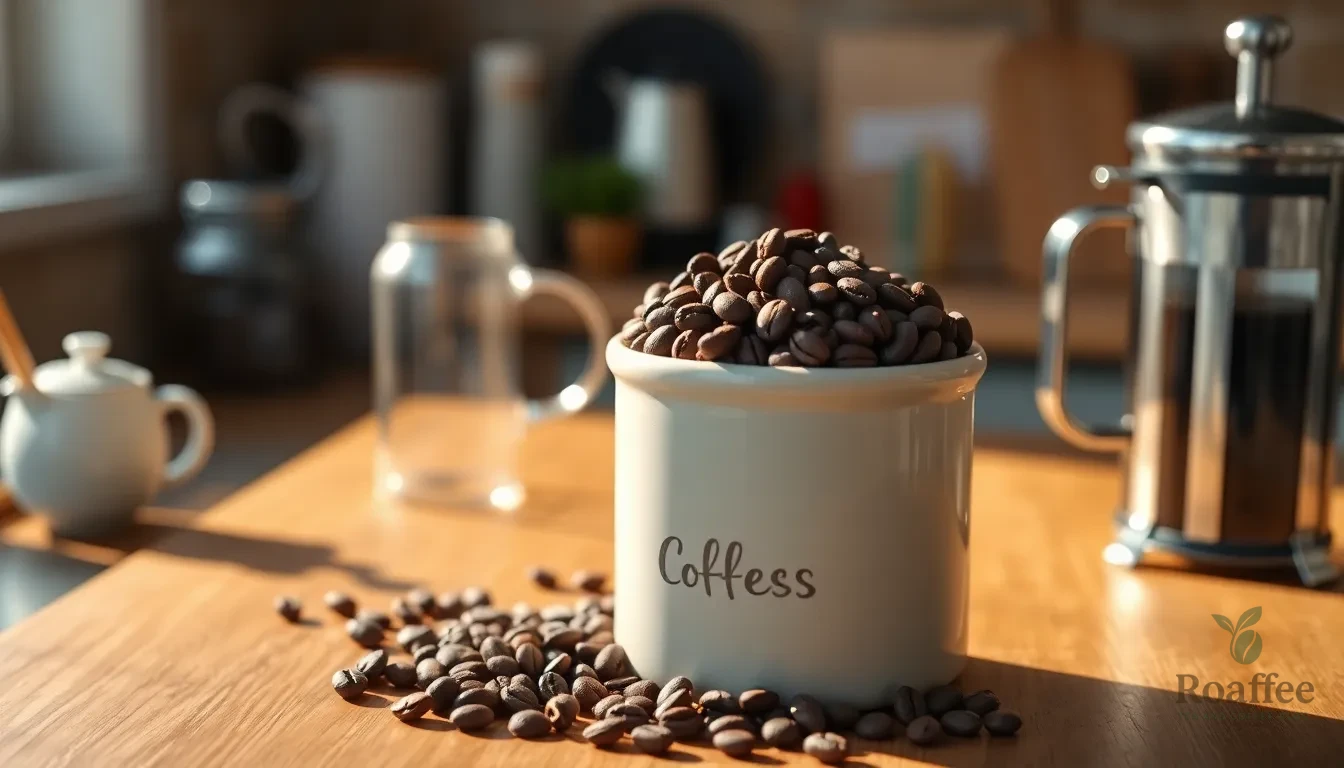
Proper storage significantly impacts the quality and flavor of our French press coffee. We recommend storing coffee beans or grounds in an airtight container made of ceramic, glass, or non-reactive metal to maintain freshness and prevent flavor degradation.
Coffee Bean Storage Requirements:
| Storage Factor | Recommendation | Reason |
|---|---|---|
| Container Material | Ceramic, glass, or non-reactive metal | Prevents flavor contamination |
| Seal Type | Airtight | Blocks oxygen exposure |
| Location | Away from moisture, heat, light, and strong odors | Preserves natural oils and flavors |
| Refrigeration | Not recommended | Moisture can degrade flavor |
We always keep our coffee away from moisture, heat, light, and strong odors that can compromise the beans’ natural characteristics. The refrigerator poses particular risks due to moisture exposure, which degrades coffee flavor over time.
French Press Equipment Care:
After each use, we rinse and clean all French press parts thoroughly to maintain quality and taste. This practice prevents coffee oil buildup that can create bitter flavors in future brews. We recommend washing the carafe, plunger, and filter with warm soapy water immediately after brewing.
Sustainable Disposal:
We compost spent coffee grounds rather than pouring them down the drain. This environmentally friendly approach prevents plumbing issues while providing nutrient-rich material for gardens. Coffee grounds add nitrogen to compost bins and improve soil structure when properly composted.
Following these storage guidelines helps us maintain the rich, full-bodied flavor that makes French press coffee exceptional. Fresh storage practices ensure each cup delivers the complex flavors and aromas we expect from properly brewed coffee.
Conclusion
Mastering the French press isn’t just about following steps—it’s about understanding how each element contributes to your perfect cup. We’ve covered everything from selecting the right beans to troubleshooting common issues because every detail matters when you’re brewing coffee this way.
The beauty of French press brewing lies in its simplicity and the control it gives you over your coffee’s flavor profile. With the right technique water temperature and timing you’ll consistently produce rich full-bodied coffee that showcases the beans’ natural characteristics.
Remember that great French press coffee starts with quality ingredients and proper maintenance. Keep your equipment clean use fresh beans and don’t be afraid to adjust variables like grind size and brewing time until you find your ideal taste.
Now it’s time to put these techniques into practice and enjoy the rewarding experience of brewing exceptional coffee at home.
Frequently Asked Questions
What is the ideal grind size for French press coffee?
The ideal grind size for French press coffee is coarse, resembling coarse sea salt. This prevents clogging of the filter and ensures even extraction. Using a burr grinder helps achieve consistent particle size, which is crucial for optimal flavor extraction and preventing fine particles from escaping through the mesh filter.
How long should I steep French press coffee?
French press coffee should steep for exactly 4 minutes. This timing allows for proper extraction of flavors and oils without over-extracting, which can lead to bitterness. Use a timer to ensure consistency, and pour immediately after pressing to prevent continued extraction.
What’s the best coffee-to-water ratio for French press?
The recommended coffee-to-water ratio for French press is 1:15 or 1:16. This typically translates to 30-60 grams of coffee depending on your French press capacity. Use a digital scale for precise measurements to ensure consistent strength and flavor in every brew.
What water temperature should I use for French press brewing?
The optimal water temperature for French press brewing is 200-205°F. This temperature range ensures proper extraction without scorching the coffee grounds. If you don’t have a thermometer, bring water to a boil and let it cool for about 30 seconds before pouring.
How do I prevent coffee grounds from ending up in my cup?
To prevent grounds in your cup, use a coarse grind and press the plunger slowly and steadily. Don’t force or rush the pressing process. A properly coarse grind combined with gentle pressure will keep most particles above the filter mesh.
How often should I clean my French press?
Clean your French press after each use with warm soapy water, paying special attention to the filter assembly. Perform a deep cleaning weekly by soaking all components in warm soapy water and scrubbing away coffee buildup to prevent stale flavors.
Can I prepare French press coffee in advance?
Yes, you can prep components ahead of time. Pre-grind coffee beans up to 24 hours in advance and store in an airtight container. You can also pre-portion grounds and set up your French press the night before to streamline your morning routine.
Why does my French press coffee taste bitter?
Bitter coffee typically results from over-extraction caused by too fine a grind, excessive brewing time, or water that’s too hot. Try using a coarser grind, reducing steeping time to 4 minutes, and ensuring water temperature stays around 205°F.
How should I store my coffee beans for French press brewing?
Store whole coffee beans in an airtight container made of ceramic, glass, or non-reactive metal. Keep them away from heat, light, and strong odors. Avoid refrigeration due to moisture risks. Use beans within two weeks of roasting for optimal freshness.
What type of coffee beans work best for French press?
Medium to dark roast whole coffee beans work best for French press brewing. These roasts complement the immersion brewing method and full-bodied extraction style. Always use fresh beans roasted within two weeks of brewing for the best flavor and aroma.




































